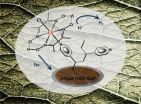(Press-News.org) A team of University of Notre Dame researchers led by Mayland Chang and Shahriar Mobashery have discovered a new class of antibiotics to fight bacteria such as methicillin-resistant Staphylococcus aureus (MRSA) and other drug-resistant bacteria that threaten public health. Their research is published in the Journal of the American Chemical Society in an article titled "Discovery of a New Class of Non-beta-lactam Inhibitors of Penicillin-Binding Proteins with Gram-Positive Antibacterial Activity."
The new class, called oxadiazoles, was discovered in silico (by computer) screening and has shown promise in the treatment of MRSA in mouse models of infection. Researchers who screened 1.2 million compounds found that the oxadiazole inhibits a penicillin-binding protein, PBP2a, and the biosynthesis of the cell wall that enables MRSA to resist other drugs. The oxadiazoles are also effective when taken orally. This is an important feature as there is only one marketed antibiotic for MRSA that can be taken orally.
MRSA has become a global public-health problem since the 1960s because of its resistance to antibiotics. In the United States alone, 278,000 people are hospitalized and 19,000 die each year from infections caused by MRSA. Only three drugs currently are effective treatments, and resistance to each of those drugs already exists.
The researchers have been seeking a solution to MRSA for years. "Professor Mobashery has been working on the mechanisms of resistance in MRSA for a very long time," Chang said. "As we understand what the mechanisms are, we can devise strategies to develop compounds against MRSA."
"Mayland Chang and Shahriar Mobashery's discovery of a class of compounds that combat drug resistant bacteria such as MRSA could save thousands of lives around the world. We are grateful for their leadership and persistence in fighting drug resistance," said Greg Crawford, dean of the College of Science at the University of Notre Dame.
INFORMATION:
Co-authors of the study include Peter O'Daniel, Zhihong Peng, Hualiang Pi, Sebastian Testero, Derong Ding, Edward Spink, Erika Leemans, Marc Boudreau, Takao Yamaguchi, Valerie Schroeder, William Wolter, Leticia Llarrull, Wei Song, Elena Lastochkin, Malika Kumarasiri, Nuno Antunes, Mana Espahbodi, Katerina Lichtenwalter, Mark Suckow, Sergei Vakulenko, Mobashery and Chang, from the Department of Chemistry and Biochemistry, the Freimann Life Sciences Center and the Department of Biological Sciences, all at the University of Notre Dame.
Notre Dame chemists discover new class of antibiotics
2014-03-07
ELSE PRESS RELEASES FROM THIS DATE:
New theory on cause of endometriosis
2014-03-07
Changes to two previously unstudied genes are the centerpiece of a new theory regarding the cause and development of endometriosis, a chronic and painful disease affecting 1 in 10 women.
The discovery by Northwestern Medicine scientists suggests epigenetic modification, a process that enhances or disrupts how DNA is read, is an integral component of the disease and its progression. Matthew Dyson, research assistant professor of obstetrics and gynecology at Northwestern University Feinberg School of Medicine and and Serdar Bulun, MD, chair of obstetrics and gynecology ...
Bone turnover markers predict prostate cancer outcomes
2014-03-07
(SACRAMENTO, Calif.) —Biomarkers for bone formation and resorption predict outcomes for men with castration-resistant prostate cancer, a team of researchers from UC Davis and their collaborators have found. Their study, published online in the Journal of the National Cancer Institute, also found that the markers identified a small group of patients who responded to the investigational drug atrasentan. The markers' predictive ability could help clinicians match treatments with individual patients, track their effectiveness and affect clinical trial design.
Castration-resistant ...
Promising news for solar fuels from Berkeley Lab researchers at JCAP
2014-03-07
There's promising news from the front on efforts to produce fuels through artificial photosynthesis. A new study by Berkeley Lab researchers at the Joint Center for Artificial Photosynthesis (JCAP) shows that nearly 90-percent of the electrons generated by a hybrid material designed to store solar energy in hydrogen are being stored in the target hydrogen molecules.
Gary Moore, a chemist and principal investigator with Berkeley Lab's Physical Biosciences Division, led an efficiency analysis study of a unique photocathode material he and his research group have developed ...
Anti-psychotic medications offer new hope in the battle against glioblastoma
2014-03-07
Researchers at the University of California, San Diego School of Medicine have discovered that FDA-approved anti-psychotic drugs possess tumor-killing activity against the most aggressive form of primary brain cancer, glioblastoma. The finding was published in this week's online edition of Oncotarget.
The team of scientists, led by principal investigator, Clark C. Chen, MD, PhD, vice-chairman, UC San Diego, School of Medicine, division of neurosurgery, used a technology platform called shRNA to test how each gene in the human genome contributed to glioblastoma growth. ...
Agricultural fires across the Indochina landscape
2014-03-07
Agricultural fires are still burning in Indochina ten days after the last NASA web posting about the fires. This natural-color image, taken on March 07, 2014, by the Moderate Resolution Imaging Spectroradiometer, MODIS, aboard the Aqua satellite, shows a more comprehensive area of burning agricultural fires that stretch from Burma through to Laos and south throughout Thailand. Actively burning areas, detected by MODIS's thermal bands, are outlined in red.Fire is used in cropland areas for pest and weed control and to prepare fields for planting. Crop residue burning helps ...
NYU researchers find majority of Latinas are unaware of their risk of diabetes
2014-03-07
Approximately 5.5 million Latinas suffer from elevated fasting plasma glucose (FPG) and nearly 4 million of those women were never told by a healthcare provider they were at risk for diabetes, pre-diabetes, or were borderline for diabetes.
The study, "Latinas with Elevated Fasting Plasma Glucose: An Analysis Using NHANES 2009-2010 Data," led by Dr. Shiela M. Strauss, Associate Professor, New York University College of Nursing (NYUCN), points to the urgent need for alternate sites of opportunity for diabetes screenings. There is also a need for effective and culturally ...
Smartphones become 'eye-phones' with low-cost devices developed by Stanford
2014-03-07
STANFORD, Calif. — Researchers at the Stanford University School of Medicine have developed two inexpensive adapters that enable a smartphone to capture high-quality images of the front and back of the eye. The adapters make it easy for anyone with minimal training to take a picture of the eye and share it securely with other health practitioners or store it in the patient's electronic record.
"Think Instagram for the eye," said one of the developers, assistant professor of ophthalmology Robert Chang, MD.
The researchers see this technology as an opportunity to increase ...
For older drivers, study finds, 1 drink may be 1 too many
2014-03-07
GAINESVILLE, Fla. — You may have only had one glass of wine with dinner, but if you're 55 or older, that single serving may hit you hard enough to make you a dangerous driver.
So, baby boomers, what you suspected is true: you can't party like you used to.
Sara Jo Nixon, Ph.D., a professor in the departments of psychiatry and psychology at the University of Florida and doctoral candidate Alfredo Sklar tested how drinking legally non-intoxicating levels of alcohol affect the driving skills of two age groups: 36 people ages 25 to 35 and 36 people ages 55 to 70. They found ...
Software analyzes apps for malicious behavior
2014-03-07
This news release is available in German.
Last year at the end of July the Russian software company "Doctor Web" detected several malicious apps in the app store "Google Play". Downloaded on a smartphone, the malware installed — without the permission of the user — additional programs which sent expensive text messages to premium services. Although Doctor Web, according to its own statement, informed Google immediately, the malicious apps were still available for download for several days. Doctor Web estimates that in this way up to 25,000 smartphones were used ...
Cells appearing normal may actually be harbingers of lung cancer
2014-03-07
HOUSTON -- Seemingly healthy cells may in fact hide clues that lung cancer will later develop, according to a study led by researchers at The University of Texas MD Anderson Cancer Center The research is published online in the Journal of the National Cancer Institute.
Examination of gene expression in patients with non-small cell lung cancer (NSCLC) showed the area adjacent to tumors is rich with cancer markers. In addition, researchers discovered the previously unknown role of a cancer-promoting gene in the airways of smokers with lung cancer.
"We believe this study ...




